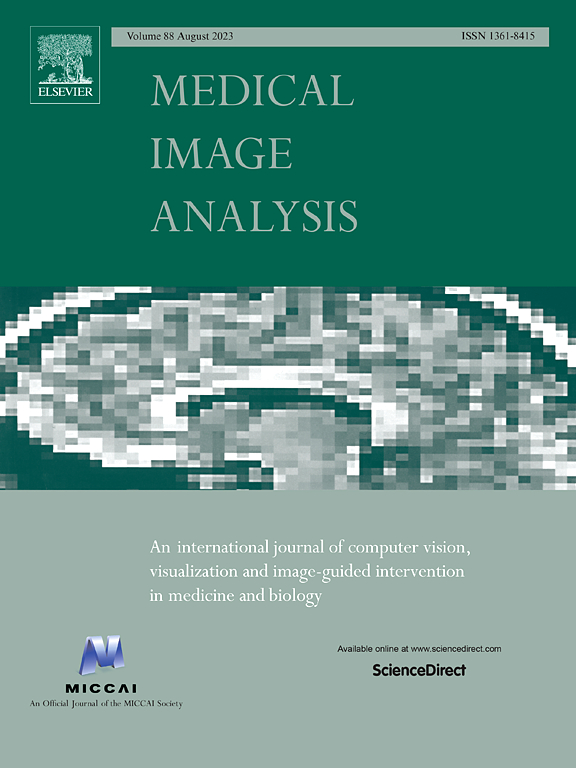Semi-supervised medical image segmentation via weak-to-strong perturbation consistency and edge-aware contrastive representation
IF 10.7
1区 医学
Q1 COMPUTER SCIENCE, ARTIFICIAL INTELLIGENCE
引用次数: 0
Abstract
Despite that supervised learning has demonstrated impressive accuracy in medical image segmentation, its reliance on large labeled datasets poses a challenge due to the effort and expertise required for data acquisition. Semi-supervised learning has emerged as a potential solution. However, it tends to yield satisfactory segmentation performance in the central region of the foreground, but struggles in the edge region. In this paper, we propose an innovative framework that effectively leverages unlabeled data to improve segmentation performance, especially in edge regions. Our proposed framework includes two novel designs. Firstly, we introduce a weak-to-strong perturbation strategy with corresponding feature-perturbed consistency loss to efficiently utilize unlabeled data and guide our framework in learning reliable regions. Secondly, we propose an edge-aware contrastive loss that utilizes uncertainty to select positive pairs, thereby learning discriminative pixel-level features in the edge regions using unlabeled data. In this way, the model minimizes the discrepancy of multiple predictions and improves representation ability, ultimately aiming at impressive performance on both primary and edge regions. We conducted a comparative analysis of the segmentation results on the publicly available BraTS2020 dataset, LA dataset, and the 2017 ACDC dataset. Through extensive quantification and visualization experiments under three standard semi-supervised settings, we demonstrate the effectiveness of our approach and set a new state-of-the-art for semi-supervised medical image segmentation. Our code is released publicly at https://github.com/youngyzzZ/SSL-w2sPC.
基于弱-强扰动一致性和边缘感知对比表示的半监督医学图像分割
尽管监督学习在医学图像分割中表现出了令人印象深刻的准确性,但由于数据采集需要努力和专业知识,它对大型标记数据集的依赖带来了挑战。半监督学习已经成为一种潜在的解决方案。然而,它往往在前景的中心区域产生令人满意的分割性能,但在边缘区域挣扎。在本文中,我们提出了一个创新的框架,有效地利用未标记的数据来提高分割性能,特别是在边缘区域。我们提出的框架包括两种新颖的设计。首先,我们引入了具有相应特征扰动一致性损失的弱到强摄动策略,以有效地利用未标记数据并指导我们的框架学习可靠区域。其次,我们提出了一种边缘感知的对比损失,利用不确定性来选择正对,从而使用未标记的数据学习边缘区域的判别像素级特征。通过这种方式,该模型最大限度地减少了多个预测的差异,提高了表示能力,最终目标是在主区域和边缘区域都取得令人印象深刻的性能。我们对公开的BraTS2020数据集、LA数据集和2017年ACDC数据集的分割结果进行了对比分析。通过三种标准半监督设置下的大量量化和可视化实验,我们证明了该方法的有效性,并为半监督医学图像分割设定了新的技术水平。我们的代码在https://github.com/youngyzzZ/SSL-w2sPC公开发布。
本文章由计算机程序翻译,如有差异,请以英文原文为准。
求助全文
约1分钟内获得全文
求助全文
来源期刊

Medical image analysis
工程技术-工程:生物医学
CiteScore
22.10
自引率
6.40%
发文量
309
审稿时长
6.6 months
期刊介绍:
Medical Image Analysis serves as a platform for sharing new research findings in the realm of medical and biological image analysis, with a focus on applications of computer vision, virtual reality, and robotics to biomedical imaging challenges. The journal prioritizes the publication of high-quality, original papers contributing to the fundamental science of processing, analyzing, and utilizing medical and biological images. It welcomes approaches utilizing biomedical image datasets across all spatial scales, from molecular/cellular imaging to tissue/organ imaging.
 求助内容:
求助内容: 应助结果提醒方式:
应助结果提醒方式:


